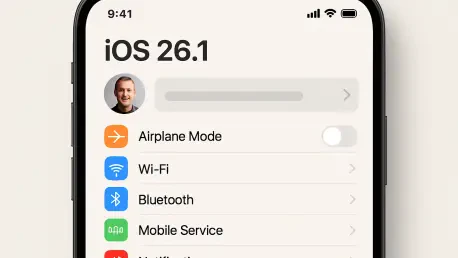In a world where smartphone interfaces are as much about personal expression as functionality, Apple’s latest move to refine its operating system with a highly customizable user interface has sparked significant buzz among tech enthusiasts and everyday users alike. The company recently rolled out release candidates for iOS 26.1, alongside updates for macOS Tahoe 26.1, iPadOS 26.1, watchOS 26.1, tvOS 26.1, and visionOS 26.1, signaling that the official launch is just around the corner. This milestone, typically the final step before public release, indicates that Apple is polishing the last details to ensure a smooth rollout across its ecosystem of devices. With an expected debut in early November, based on historical patterns, anticipation is building for what promises to be a transformative update. A standout feature, the innovative Liquid Glass UI, has already captured attention for its sleek design, though not without some debate. This development underscores Apple’s ongoing commitment to balancing cutting-edge aesthetics with user-friendly customization.
Final Steps Before Launch
The release candidates for Apple’s suite of operating systems mark a critical phase in the journey toward public availability. Distributed to developers and public beta testers on a recent Tuesday, these builds represent the last opportunity to identify and address any lingering issues before the software reaches millions of users worldwide. This testing phase is essential for ensuring compatibility with third-party applications and maintaining system stability across a diverse range of devices, from iPhones to Vision Pro headsets. Apple’s structured approach to this rollout, with synchronized updates for all platforms, reflects a dedication to delivering a cohesive experience. By involving both registered developers and beta program participants, the company casts a wide net to gather feedback, ensuring that the final product meets high standards of reliability and performance. This meticulous process highlights the significance of these release candidates as more than just a formality, but as a cornerstone of quality assurance.
Moreover, the timing of these release candidates offers a clear hint at the impending launch. Historically, Apple tends to transition from this stage to a full release within a matter of days, often aligning with early November dates. This pattern suggests that users can soon expect to download the updates on their devices, bringing a host of new features and refinements. Beyond the technical aspects, this phase also builds momentum among the user base, as discussions and previews circulate widely in tech communities. The uniformity of the release strategy across different operating systems further demonstrates Apple’s intent to create a seamless integration, whether someone is interacting with an iPad or an Apple TV. This synchronized effort not only streamlines the deployment but also reinforces the interconnected nature of Apple’s product ecosystem, setting the stage for a unified user experience that feels both familiar and refreshed.
Innovation in User Interface Design
At the heart of the upcoming iOS 26.1 update lies the Liquid Glass user interface, a visually captivating feature that introduces a translucent, fluid effect to elements like the Dock and Control Center. This design creates an illusion of depth, as if users are looking through a pane of glass to see content layered beneath, offering a modern and dynamic aesthetic that sets it apart from traditional interfaces. While many have praised this approach for its innovative flair, it has not been without criticism, as some find the transparency distracting or challenging to navigate. Apple’s response to these mixed reactions showcases a willingness to adapt, ensuring that the feature enhances rather than hinders usability. This balance between pushing creative boundaries and maintaining practicality defines the company’s approach to interface evolution, making Liquid Glass a focal point of discussion as the release date approaches.
Recognizing the diversity of user preferences, Apple has introduced new customization options for Liquid Glass in this update. Within the Settings app, under Display & Brightness, users can now select between a “Clear” mode for heightened transparency or a “Tinted” mode that boosts opacity and contrast for better readability. This adjustment stands apart from the more comprehensive “Reduce Transparency” option found in Accessibility settings, offering a tailored solution specifically for this feature. Such flexibility empowers users to shape their experience according to personal taste or functional needs, addressing concerns about visual clutter or accessibility. By embedding these choices directly into the system settings, Apple demonstrates an attentiveness to feedback that not only refines the current update but also sets a precedent for future iterations. This adaptability ensures that the interface remains a tool for expression rather than a source of frustration.
Reflecting on a Responsive Rollout
Looking back, Apple’s handling of the release candidates for iOS 26.1 and its companion updates revealed a thoughtful blend of innovation and user consideration. The introduction of the Liquid Glass UI, while bold, was met with constructive adjustments that prioritized customization, allowing users to tailor their visual experience. The rigorous testing phase with developers and beta testers played a pivotal role in smoothing out potential issues before the software reached the broader public. Moving forward, attention should turn to how these updates perform in real-world scenarios post-launch, particularly whether the customization options for Liquid Glass meet the diverse needs of users globally. Keeping an eye on community feedback and subsequent patches will be crucial, as these insights could shape further refinements. Additionally, exploring how this update integrates with emerging hardware or features in the pipeline offers an exciting avenue for speculation and analysis, ensuring that Apple’s ecosystem continues to evolve in meaningful ways.









